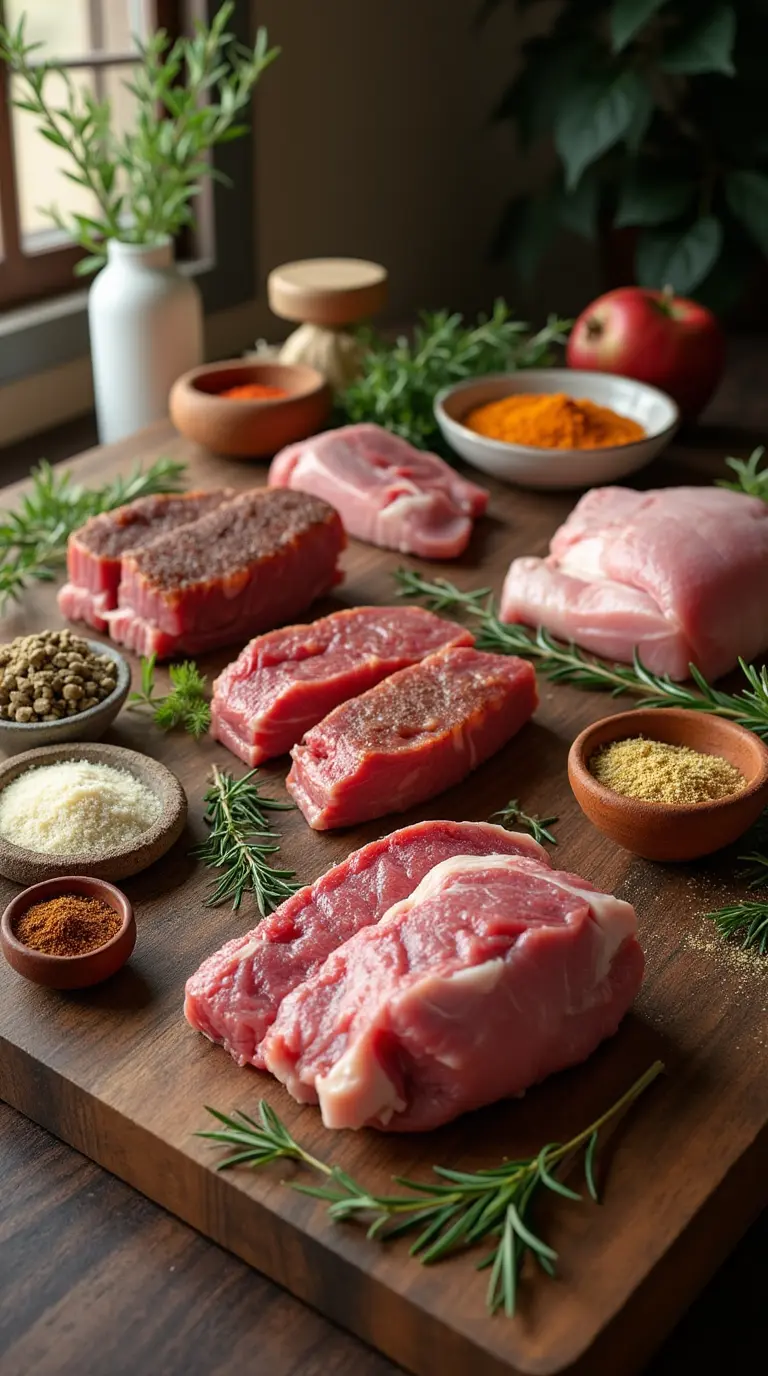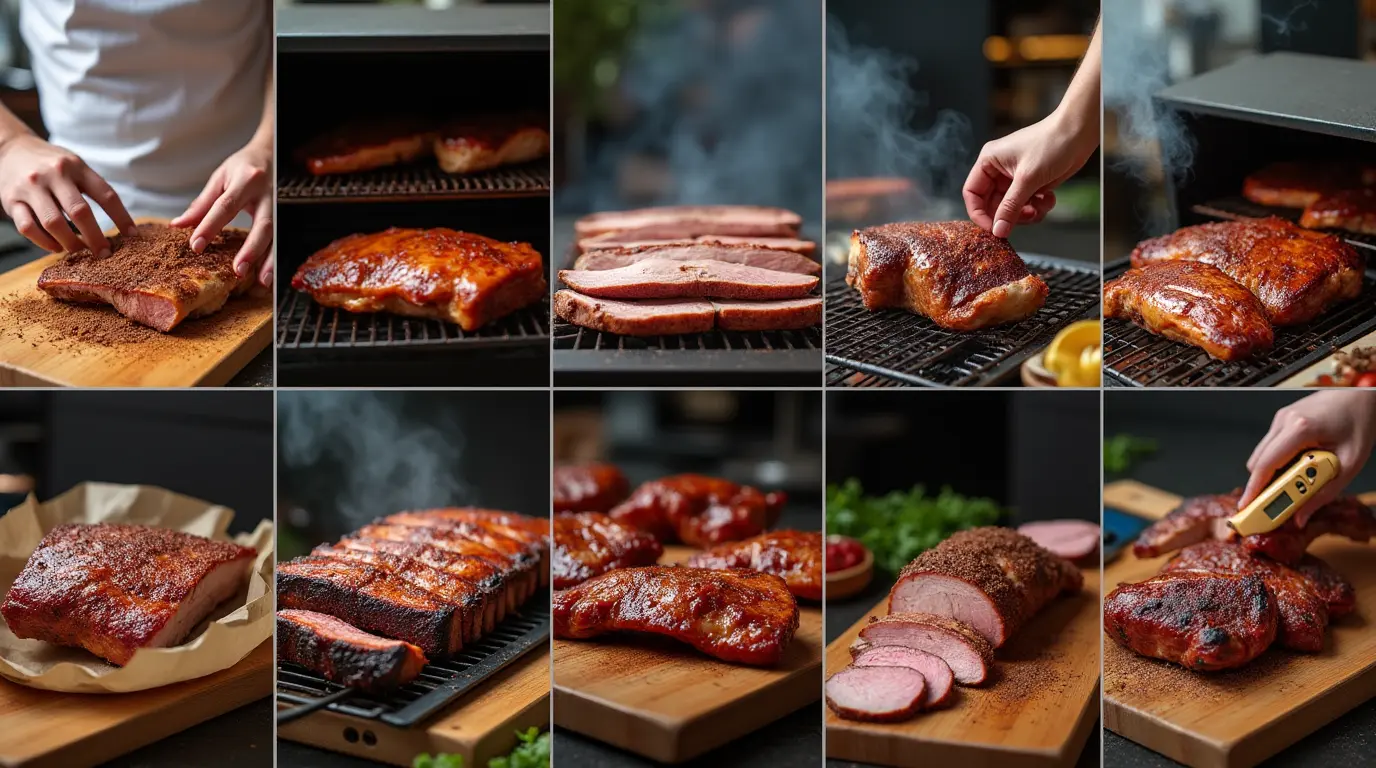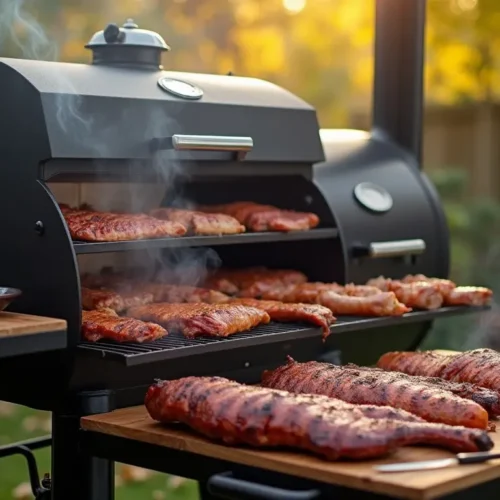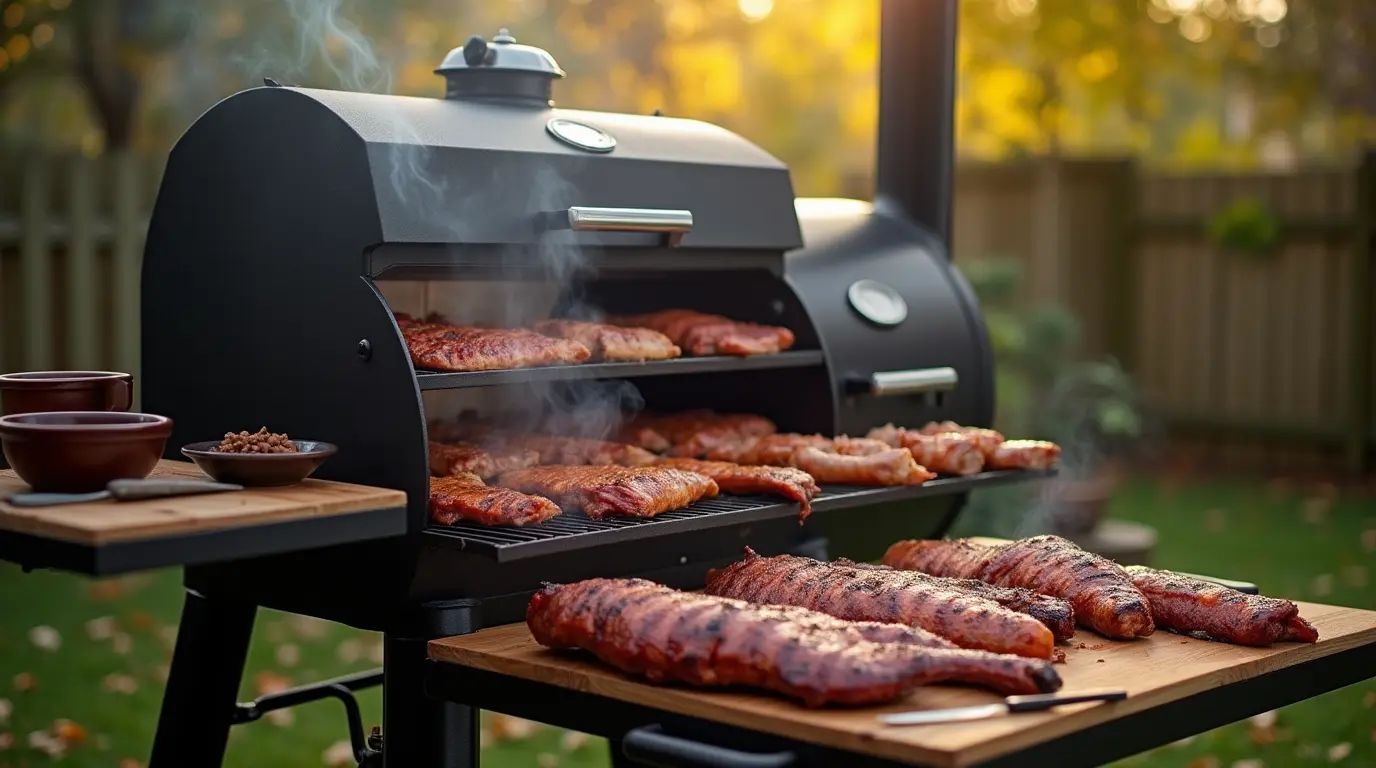Smoking meat is an art that brings out incredible flavors, tenderness, and a mouthwatering smoky aroma. Whether you’re a seasoned pitmaster or just starting, the best smoker recipes can elevate your BBQ game. From smoked chicken to smoked turkey, each cut of meat offers its own unique flavors when cooked low and slow. Have you ever experienced the joy of a perfectly juicy smoked brisket or the irresistible crispness of smoked ribs? These recipes are not only delicious but also incredibly versatile, giving you endless options to experiment with different wood chips, rubs, and marinades. Get ready to explore 7 juicy meats that are guaranteed to impress your family and friends at your next cookout!
Table of Contents
1. Key Benefits of Smoking Meat
Smoking meat isn’t just about creating delicious, tender dishes, it’s an experience that brings people together. Here’s why smoking meats is a game-changer for any cookout:
- Intense Flavor: Smoking infuses meats with rich, smoky flavors that grilling or baking simply can’t replicate. Whether you choose smoked chicken, smoked turkey, or smoked lamb, the result is a deep, savory taste that everyone will love.
- Tender and Juicy: The magic of low and slow cooking breaks down the fibers in meats, making them incredibly tender. With the right smoker temperature control, you’ll achieve that melt-in-your-mouth texture every time.
- Versatility: Smoking offers endless options. You can experiment with different wood chips like hickory, applewood, or mesquite to create unique flavor profiles. Plus, you can adapt rubs and marinades to suit your tastes, making it a great choice for both beginners and seasoned cooks.
- Healthy Cooking: Since smoking uses minimal oil and relies on natural flavors, it’s a healthier way to enjoy meats without sacrificing taste. Plus, the smoking process can render out some of the fat, resulting in a leaner meal.
- Impress Your Guests: Whether you’re hosting a backyard BBQ or a special occasion, smoked meats like brisket or smoked sausage will make a lasting impression. There’s something about the process of smoking that makes it feel like a personal touch perfect for creating unforgettable memories.
By the end of this guide, you’ll have the know-how to make perfectly smoked meats every time, ensuring you bring out the best in every cut. Ready to dive into the world of smoking? Let’s get started!
2. Ingredients
Now that you’re excited about smoking meat, let’s talk ingredients. Whether you’re aiming for a perfectly smoked brisket, a juicy smoked turkey, or flavorful smoked chicken, selecting the right ingredients is key to achieving that mouthwatering result. Here’s what you’ll need for the 7 juicy meats we’re about to smoke:

Main Ingredients:
- Meat Cuts:
- Brisket (around 5-7 pounds)
- Whole Chicken (about 4 pounds)
- Turkey (8-12 pounds)
- Lamb Shoulder (3-4 pounds)
- Beef Ribs (3-4 racks)
- Chicken Thighs or Drumsticks (6-8 pieces)
- Sausage Links (1-2 pounds)
Seasonings and Rubs:
- Dry Rub or Marinade:
- 2 tablespoons of brown sugar
- 1 tablespoon of paprika
- 1 tablespoon of garlic powder
- 1 tablespoon of onion powder
- 1 teaspoon of black pepper
- 1 teaspoon of salt
- 1 teaspoon of cayenne pepper (for a little heat)
- 1 tablespoon of mustard powder (optional for tang)
- 1 tablespoon of herbs like thyme or rosemary for extra flavor
- Wood Chips/Pellets: Choose based on flavor preference, here are some great options:
- Hickory (ideal for beef)
- Applewood (great for poultry)
- Mesquite (perfect for stronger flavors, like beef and lamb)
- Cherrywood (for a slightly sweet touch, ideal with chicken and turkey)
For the Smoker:
- Water Pan: Fill a water pan halfway to maintain moisture and help regulate the temperature in the smoker.
- Smoking Tools: Ensure you have your meat thermometer on hand to monitor the internal temperature accurately.
By gathering these ingredients, you’re setting yourself up for a smoking adventure that will deliver delicious, juicy results. Remember, the seasoning and wood chips you choose will affect the flavor, so feel free to adjust based on your personal preferences. Let’s move on to the next step getting these ingredients ready for the smoker!
3. Instructions
Ready to get that smoker fired up? Whether you’re working with smoked chicken, brisket, or smoked turkey, the key to juicy, flavorful meat is patience and attention to detail. Follow these steps, and you’ll be a smoking pro in no time.

Step 1: Prep the Meat
- Trim the Fat: For certain cuts like brisket or lamb shoulder, trim the fat to about ¼ inch thick. This will help the rub penetrate the meat and prevent it from becoming too greasy.
- Apply the Rub: Generously coat your chosen meat with the dry rub or marinade. Be sure to cover every inch, giving special attention to crevices and edges. If you have time, let the rub sit on the meat for at least 30 minutes or even overnight in the fridge for maximum flavor.
Step 2: Preheat the Smoker
- Prepare the Smoker: While the meat is marinating, fire up your smoker. Set it to the ideal temperature, typically 225°F to 250°F (low and slow is the way to go).
- Add Wood Chips: If you’re using a charcoal smoker, add a handful of wood chips (such as hickory or applewood) to the coals. For pellet smokers, simply load up your pellets and adjust accordingly.
- Water Pan: If you’re using a water pan, place it in the smoker to maintain moisture, especially for longer cooks.
Step 3: Smoking the Meat
- Place the Meat on the Smoker: Once the smoker is at the right temperature, carefully place your meat on the grill grate, away from direct heat. If you’re working with multiple cuts, make sure there’s enough space for airflow.
- Monitor the Temperature: Insert your meat thermometer into the thickest part of the meat. Aim for an internal temperature of around 190°F for beef or 165°F for chicken and turkey. If you’re smoking ribs or pulled chicken, you’ll want the meat to easily pull apart, which happens when it reaches the right temperature.
- Keep the Lid Closed: Resist the urge to open the smoker too often. Opening the lid lets heat and smoke escape, affecting the cooking process. Let the meat smoke undisturbed for the recommended time typically around 3-6 hours, depending on the cut.
Step 4: Rest the Meat
When the meat hits the perfect internal temperature, take it off the smoker. Let it rest for about 10-15 minutes before slicing or pulling. This allows the juices to redistribute and ensures a juicy, tender result.
By following these steps, you’ll have perfectly smoked meats that are bursting with flavor. Whether it’s a smoked brisket with a perfect bark, or juicy smoked chicken with crispy skin, you’re guaranteed to impress everyone at your next BBQ. Now, let’s dive into some pro tips and variations to make your smoked meats even better!
4. Pro Tips and Variations
Smoking meat is all about experimentation and finding what works best for you. Here are some pro tips and variations that can take your smoked meats from good to great, ensuring each cookout is even more delicious than the last.
Pro Tips for Perfect Smoked Meats
- Low and Slow is Key: Remember, the secret to juicy smoked meats lies in cooking them at a low temperature for a long time. Keep your smoker at 225°F to 250°F for the best results. Patience pays off here, don’t rush the process.
- Use a Meat Thermometer: This is your best friend when smoking meat. Every cut has an ideal internal temperature. For example, smoked turkey should reach around 165°F, while smoked brisket should hit 190°F for that melt-in-your-mouth tenderness. Investing in a good meat thermometer will help you avoid any guessing.
- Rest Your Meat: After removing the meat from the smoker, give it time to rest. Allowing it to sit for about 10-15 minutes will ensure the juices redistribute and keep the meat moist. Don’t skip this step!
- Don’t Over-Smoke: While the wood chips bring great flavor, too much smoke can overpower your meat. Start with a small amount and monitor the smoke output throughout the cooking process.
- Wrap It Up for Extra Tenderness: For tougher cuts like brisket or lamb, consider using the Texas Crutch method: wrap the meat in foil once it reaches an internal temperature of around 150°F. This helps lock in moisture and speeds up cooking time, creating a tender, juicy result.
Variations to Try
- Wood Pairing: The wood you choose will significantly impact the flavor. If you want a mild, sweet flavor, try applewood for your smoked chicken or turkey. If you’re after a stronger, bolder taste, mesquite is a fantastic option for beef ribs and smoked sausage. Experiment with different types of wood to find your favorite.
- Marinades and Rubs: If you prefer a tangy twist, try marinating your meats in a vinegar-based marinade (perfect for smoked turkey or smoked chicken). For a savory touch, use a mustard-based rub on brisket or lamb. Don’t hesitate to get creative with your seasoning blends.
- Smoking Time and Temperature Adjustments: If you’re smoking multiple meats at once, remember that different cuts cook at different rates. For example, smoked chicken thighs may take only 2-3 hours, while a brisket can take up to 6 hours or more. Adjust your smoker temperature and times accordingly for each piece of meat.
- Add a Glaze: Halfway through the smoking process, consider glazing your meat with a BBQ sauce or honey glaze for an extra layer of flavor. A sweet and spicy glaze works wonders on smoked ribs or smoked sausage.
With these tips and variations in mind, you’re all set to become a smoking master. Whether you’re perfecting smoked brisket or trying your hand at smoked turkey, these expert suggestions will help you achieve fantastic results every time. Keep experimenting to discover new flavors and techniques that suit your taste!
5. Serving Suggestions
Now that you’ve mastered the art of smoking meats, it’s time to think about how to serve them up and make your meal even more enjoyable. The right sides, sauces, and garnishes can take your juicy, smoky creations to the next level. Here are some serving suggestions to perfectly complement your smoked brisket, smoked chicken, and other delicious cuts:
1. Pairing with Classic Sides
- Coleslaw: A tangy, crunchy coleslaw is a perfect match for smoked meats. It balances out the richness of the meat with its crisp texture and zesty flavor.
- Cornbread: Soft and slightly sweet, cornbread is a fan-favorite side dish that pairs wonderfully with the smoky flavors of smoked turkey or smoked sausage.
- Grilled Vegetables: Try grilling up some seasonal veggies like asparagus, corn on the cob, or sweet potatoes to serve alongside your smoked meats. The smoky char from the grill will echo the flavors of the smoker.
- Mac and Cheese: If you’re looking to add some indulgence, creamy mac and cheese is a perfect choice. It’s comforting, rich, and pairs wonderfully with smoked chicken thighs or smoked ribs.
2. Sauces and Condiments
- BBQ Sauce: While your smoked meats are packed with flavor, a good BBQ sauce can elevate the dish even more. For a traditional touch, go for Kansas City-style BBQ sauce with its tangy, sweet profile. If you prefer something lighter, try a Carolina vinegar-based sauce, which pairs beautifully with smoked turkey or chicken.
- Mustard Sauce: If you’re smoking brisket or lamb, a tangy mustard-based sauce can add a zesty, savory twist that complements the rich, smoky flavors.
- Pickles and Onions: Sliced pickles and onions provide a refreshing, acidic balance to the richness of smoked meats. They work especially well with smoked sausage or smoked ribs.
3. Garnishes for a Finishing Touch
- Fresh Herbs: Garnish your meats with fresh herbs like parsley or rosemary for a pop of color and a hint of freshness. This simple touch can elevate the presentation and flavor profile.
- Lemon Wedges: A squeeze of fresh lemon over smoked chicken or turkey adds a burst of acidity that helps cut through the richness of the smoke.
- Chili Flakes: If you like a little heat, sprinkle some chili flakes over your smoked meats or sides for an extra kick.
4. Drinks to Pair
- Iced Tea: For a non-alcoholic option, a refreshing glass of iced tea with a hint of lemon complements the smoky depth of the meats.
- Red Beverage: A full-bodied red beverage, like a Malbec or Cabernet Sauvignon, pairs excellently with the robust flavors of smoked ribs or brisket.
5. Serving Styles
- Family-Style Platter: For a relaxed, communal meal, serve your smoked meats family-style on a large platter. This gives everyone the chance to dig in and share the deliciousness.
- Sandwiches: For a fun twist, slice your smoked brisket or smoked chicken and serve it on a soft bun with your favorite condiments. Add some coleslaw on top for the perfect smoked meat sandwich!
By thoughtfully pairing your smoked meats with these sides, sauces, and drinks, you’ll create a balanced, memorable meal that will have everyone coming back for seconds. Whether you’re hosting a casual BBQ or a special family gathering, these serving suggestions will make your smoked meats shine and provide a delightful experience for all your guests.
6. Conclusion
Congratulations! You’ve now mastered the art of smoking meats with these best smoker recipes, and you’re ready to impress your friends and family with tender, flavorful cuts of smoked brisket, smoked chicken, smoked turkey, and more. Whether you’re a seasoned pro or a first-time smoker, the process of creating juicy, mouthwatering smoked meats is one you’ll want to repeat again and again.
To recap, remember to keep the following in mind for the best results:
- Patience is key, low and slow is the secret to tender, juicy meat.
- Use a meat thermometer to avoid guesswork and ensure perfectly cooked meat every time.
- Rest your meat before serving to lock in all those delicious juices.
- Don’t forget about the sides, sauces, and garnishes that elevate your meal to the next level.
With these tips, variations, and serving suggestions, you’re all set to create an unforgettable BBQ feast. So fire up your smoker, gather your favorite ingredients, and get ready to enjoy the rich, smoky flavors of perfectly cooked meats. Happy smoking, and enjoy every bite of your savory creations!

Best Smoker Recipes
Ingredients
Main Ingredients:
Meat Cuts:
- Brisket around 5-7 pounds
- Whole Chicken about 4 pounds
- Turkey 8-12 pounds
- Lamb Shoulder 3-4 pounds
- Beef Ribs 3-4 racks
- Chicken Thighs or Drumsticks 6-8 pieces
- Sausage Links 1-2 pounds
Seasonings and Rubs:
Dry Rub or Marinade:
- 2 tablespoons of brown sugar
- 1 tablespoon of paprika
- 1 tablespoon of garlic powder
- 1 tablespoon of onion powder
- 1 teaspoon of black pepper
- 1 teaspoon of salt
- 1 teaspoon of cayenne pepper for a little heat
- 1 tablespoon of mustard powder optional for tang
- 1 tablespoon of herbs like thyme or rosemary for extra flavor
Instructions
Step 1: Prep the Meat
- Trim the Fat: For certain cuts like brisket or lamb shoulder, trim the fat to about ¼ inch thick. This will help the rub penetrate the meat and prevent it from becoming too greasy.
- Apply the Rub: Generously coat your chosen meat with the dry rub or marinade. Be sure to cover every inch, giving special attention to crevices and edges. If you have time, let the rub sit on the meat for at least 30 minutes or even overnight in the fridge for maximum flavor.
Step 2: Preheat the Smoker
- Prepare the Smoker: While the meat is marinating, fire up your smoker. Set it to the ideal temperature, typically 225°F to 250°F (low and slow is the way to go).
- Add Wood Chips: If you’re using a charcoal smoker, add a handful of wood chips (such as hickory or applewood) to the coals. For pellet smokers, simply load up your pellets and adjust accordingly.
- Water Pan: If you’re using a water pan, place it in the smoker to maintain moisture, especially for longer cooks.
Step 3: Smoking the Meat
- Place the Meat on the Smoker: Once the smoker is at the right temperature, carefully place your meat on the grill grate, away from direct heat. If you’re working with multiple cuts, make sure there’s enough space for airflow.
- Monitor the Temperature: Insert your meat thermometer into the thickest part of the meat. Aim for an internal temperature of around 190°F for beef or 165°F for chicken and turkey. If you’re smoking ribs or pulled chicken, you’ll want the meat to easily pull apart, which happens when it reaches the right temperature.
- Keep the Lid Closed: Resist the urge to open the smoker too often. Opening the lid lets heat and smoke escape, affecting the cooking process. Let the meat smoke undisturbed for the recommended time typically around 3-6 hours, depending on the cut.
Step 4: Rest the Meat
- When the meat hits the perfect internal temperature, take it off the smoker. Let it rest for about 10-15 minutes
Notes
Nutrition Information (per serving)
- Calories: 250–500 (depending on the meat choice and serving size)
- Fat: 15-35g
- Protein: 25-40g
- Carbs: 0-5g
- Fiber: 0g
- Sugar: 0-3g
- Sodium: 500-1200mg (depending on the seasoning used)
- Cholesterol: 70-150mg
7. FAQs
Got questions? We’ve got answers! Here are some of the most frequently asked questions about smoking meats, and some handy tips to help you achieve the best results every time.
1. How much time does it take to smoke meat?
The cooking time for smoked meat depends on the type and size of the cut you’re using. Here’s a quick breakdown:
- Smoked chicken: Typically takes about 2-3 hours at 225°F.
- Smoked brisket: Expect around 6-8 hours at 225°F, depending on the size.
- Smoked turkey: It usually takes about 4-5 hours at 250°F.
- Smoked ribs: Usually about 3-4 hours.
Remember, smoking meat is about patience. Always use a meat thermometer to check the internal temperature for optimal results.
2. What wood is best for smoking meats?
The wood you choose can greatly affect the flavor of your meat. Here are some popular choices:
- Hickory: Bold and smoky, great for beef.
- Applewood: Mild and sweet, perfect for poultry like chicken or turkey.
- Mesquite: Strong and earthy, ideal for brisket and ribs.
- Cherrywood: Sweet and fruity, works well with most meats, especially beef and chicken.
Feel free to experiment with different woods or even create your own blends to find the flavor profile you love!
3. Should I wrap my meat during smoking?
Wrapping meat during smoking, also known as the Texas Crutch, helps retain moisture and speed up the cooking process. It’s particularly useful for tougher cuts like brisket or pulled beef. Here’s when to wrap:
- Brisket: Wrap in foil or butcher paper once it reaches an internal temperature of 150°F. This helps lock in moisture and allows the meat to cook faster without drying out.
- Ribs: Some prefer wrapping ribs in foil during the final stages of cooking to help retain tenderness and juiciness, though this step is optional based on your desired texture.
4. How can I keep the meat from drying out?
To keep your meat moist during the smoking process, follow these tips:
- Use a water pan: Place a water pan in the smoker to help maintain moisture and prevent the meat from drying out.
- Baste with a marinade or mop sauce: Occasionally basting your meat with a marinade or mop sauce will add flavor and moisture.
- Cook at a low and slow temperature: Smoking at a low temperature (around 225°F to 250°F) allows the meat to cook slowly and retain its juices.
5. Can I smoke meat in advance?
Absolutely! Smoked meat can be made ahead of time and stored for later. Simply:
- Let the smoked meat cool completely.
- Wrap it tightly in foil or plastic wrap, then refrigerate it.
- When ready to serve, reheat the meat in the oven or smoker to bring back some of that smoky flavor.
If you’re planning to make a large batch, smoking in advance can help save time for big events or family gatherings.
6. How do I know when my smoked meat is done?
Using a meat thermometer is the most reliable way to check the doneness of smoked meat. Here are the ideal internal temperatures for various meats:
- Chicken: 165°F
- Beef (Brisket): 190°F
- Ribs: 190-203°F
- Turkey: 165°F
For extra tenderness, especially with brisket or pulled beef, make sure the meat reaches the target temperature and can easily be pulled apart with a fork.
7. Can I smoke vegetables too?
Yes, you can! Many vegetables take on an amazing flavor when smoked. Try smoking:
- Corn on the cob: Smoked corn has a sweet, smoky flavor that pairs perfectly with smoked meats.
- Asparagus: A quick smoke gives asparagus a delicious charred flavor.
- Potatoes: Smoke them whole or cut into wedges for a hearty side dish.
Smoking vegetables is a great way to add depth and variety to your meal. Just be sure to monitor them closely as they cook faster than meat.
We hope these answers help clarify some of your smoking questions! With these tips and tricks, you’re well on your way to becoming a smoking expert. Keep experimenting and adjusting to your taste, and most importantly, have fun with the process. Happy smoking!

